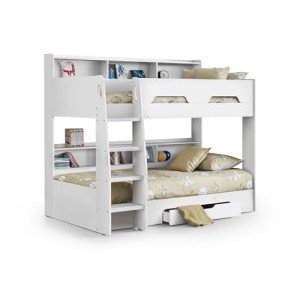Exploring Bunk Beds: A Comprehensive Guide
bunk bed for teens beds have actually long been a staple in kids's bedrooms, dorms, and even homes with minimal space. Not just do they supply a practical sleeping service, but they also develop an enjoyable and creative environment for children and a great space-saver for adults and families. This post will check out everything you require to learn about bunk beds, from types and materials to security ideas and buying suggestions.
Table of Contents
- Types of Bunk Beds
- Conventional Bunk Beds
- Loft Beds
- Triple Bunk Beds
- L-Shaped Bunk Beds
- Product Options
- Wood
- Metal
- Security Considerations
- Purchasing Guide
- Frequently asked questions
Types of Bunk Beds
Bunk beds can be found in various styles to fit various needs and choices. Here's a breakdown of the most typical types:

Conventional Bunk Beds
Traditional bunks typically include two beds stacked vertically on top of one another. These beds are ideal for siblings sharing a space or for taking full advantage of sleeping space in visitor rooms.
Loft Beds
Loft beds stand likewise to conventional bunk beds however do not have a lower sleeping area. Instead, they frequently incorporate a desk or seating location underneath, making them a great choice for small spaces requiring multifunctionality.
Triple Bunk Beds
Triple childrens bunk beds uk (www.arlenusry.top) beds are developed for 3 occupants, with beds stacked in a three-tier setup. These are less common but can be an enjoyable service for large households or slumber parties.
L-Shaped Bunk Beds
With one bed positioned horizontally and the other vertically, L-shaped bunk beds are typically equipped with additional functions such as desks or storage drawers and can match corner areas in a room.
Comparison of Bunk Bed Types
| Bed Type | Ideal Use | Description |
|---|---|---|
| Conventional | Shared bed rooms or guest spaces | Two beds stacked vertically |
| Loft | Small rooms requiring multi-purpose space | Upper bed with open space underneath |
| Triple | Big families or sleepovers | 3 beds stacked vertically |
| L-Shaped | Corner or versatile areas | A combination of vertical and horizontal beds |
Material Options
Bunk beds are made from various products, with wood and metal being the most common. Each material has its advantages and disadvantages.
Wood
- Resilience: Generally robust and can hold up against years of use.
- Aesthetic Appeal: Offers a traditional appearance that can blend with numerous decorations.
- Weight Capacity: Typically stronger; can support much heavier weights.
- Drawbacks: May be more costly than metal options and can be prone to scratches.
Metal
- Toughness: Generally lightweight and easy to move but still strong.
- Modern Design: Often comes in streamlined styles, making it appealing for contemporary areas.
- Cost-efficient: Usually cheaper than wooden choices.
- Disadvantages: Can be cold to the touch in winters and may not have the very same aesthetic appeal for some buyers.
Safety Considerations
When it pertains to bunk bed for sale beds, security can not be neglected. Here are crucial safety pointers to remember:
- Guardrails: Ensure that the top bunk has guardrails on both sides to prevent falls.
- Strong Construction: Check for a solid construct and tough products to withstand weight and movement.
- Weight Limit: Adhere to the manufacturer's weight limitation for both the upper and lower bunks.
- Ladder Design: Choose bunks with a safe, easy-to-climb ladder and prevent any sharp edges or rungs.
- Age Restrictions: Most makers recommend that kids under the age of six should not sleep in the upper bunk.
Buying Guide
When searching for bunk beds, think about the list below elements to find the very best fit for your requirements:
- Space Availability: Measure the space size and ceiling height, guaranteeing there is appropriate space for the leading bunk beds for sale.
- Bed Size: Decide between twin, full, or larger sizes based upon your needs and the size of the space.
- Design Preference: Consider the total design of the bedroom to discover an appropriate design.
- Ease of Setup: Look for a bunk bed that is uncomplicated to assemble.
- Spending plan: Bunk beds can be found in different rate ranges, so determine a budget before beginning your search.
FAQs
1. What is the recommended age for kids to sleep on the top bunk?
Kids aged 6 and older are usually suggested to sleep on the leading bunk to minimize the danger of falls.
2. How can I make my bunk bed more secure?
To improve safety, ensure guardrails are appropriately set up and examine that the bed is put on a flat surface. In addition, motivate children to utilize the ladder carefully.
3. Can I transform a bunk bed into 2 different beds?
Numerous bunk beds are designed to be convertible. Check the producer's requirements for convertibility functions.
4. What devices are readily available for bunk beds?
Typical devices include beddings, storage drawers, staircases instead of ladders, and tented canopies for a fun visual appeal.
5. How do I maintain my bunk bed?
Regular look for loose screws or structural stability can help make sure safety. Dust the bed routinely and tidy spills quickly to keep the materials in good condition.
Bunk beds are flexible and a space-efficient service for numerous living situations, from children's rooms to visitor lodgings. With numerous styles and products offered, possible buyers have a wealth of alternatives to think about, guaranteeing a combination of usefulness and aesthetic appeals. By focusing on safety and following the tips detailed in this guide, individuals can discover the ideal bunk bed that matches their space and lifestyle, all while producing an enjoyable sleeping environment.








